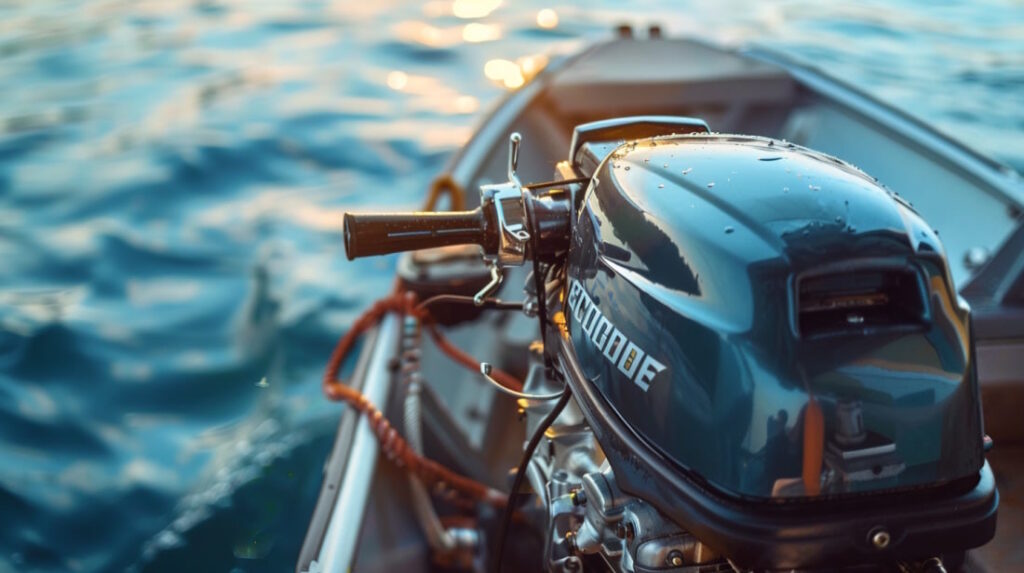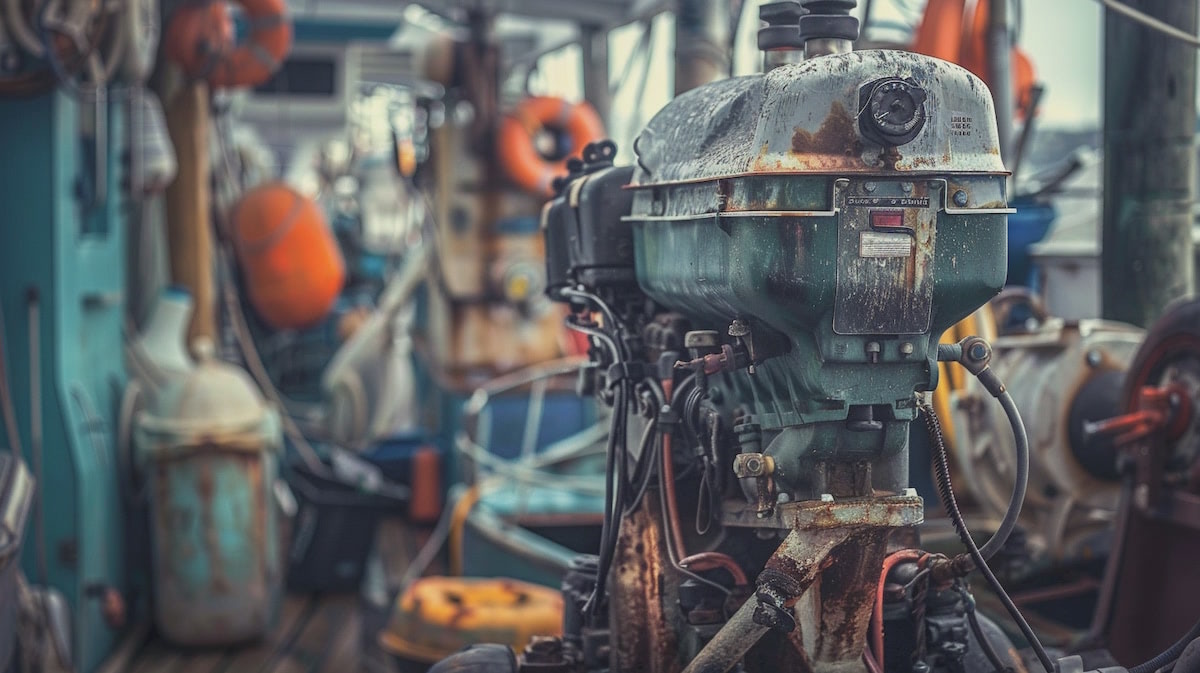Maintaining your boat motor is essential for ensuring a smooth and safe boating experience. Regular boat motor maintenance extends the engine’s life and improves performance, reliability, and fuel efficiency. This article is a guide on how to maintain a boat motor. It covers basic upkeep and advanced care techniques. If you have a boat, these tips can help you maintain your motor in good condition.
Understanding Your Boat Motor
Maintaining a boat motor efficiently requires a thorough understanding of its structure and functionality. Boat motors come in various types and have numerous components that require regular attention. Knowing the type of motor you have and how it operates is the first step in effective boat motor maintenance.
Types of Boat Motors
Boat motors are primarily categorized into two main types: outboard and inboard engines. Each type has distinct features and advantages, and their maintenance requirements differ.
- Outboard Motors: These are the most common type and are mounted outside the boat on the transom. They are compact, easy to service, and provide steering by pivoting the entire engine. Outboards are ideal for small to medium-sized boats and are often used for recreational boating and fishing.
- Inboard Motors: Installed inside the boat’s hull, inboard motors connect directly to the propeller via a driveshaft. They are typically more powerful than outboards and are used in larger vessels, including sailboats and yachts. Inboards provide a smoother ride and better weight distribution but require more complex maintenance due to their internal placement.
- Stern Drive (Inboard/Outboard) Motors: Combining features of both inboard and outboard engines, stern drive motors are mounted inside the boat but steer via an outboard-like pivoting drive unit. They offer high performance and easy maintenance access but can be more challenging to repair than pure outboards.
Understanding the type of motor on your boat helps tailor your maintenance approach, ensuring that you follow the appropriate procedures and use the correct tools and parts.

Key Components of Boat Motors
Regardless of the type, boat motors consist of several key components that require regular inspection and maintenance:
- Powerhead: This is the engine itself, where fuel combustion occurs. It includes the cylinders, pistons, and crankshaft. The powerhead generates the power needed to drive the boat.
- Midsection: The midsection houses the exhaust system and connects the powerhead to the lower unit. It also contains the mounting bracket that secures the motor to the boat.
- Lower Unit (Gearcase): This part contains the gearbox and driveshaft, transferring power from the engine to the propeller. The lower unit also includes the water pump, which circulates cooling water through the engine.
- Propeller: Attached to the lower unit, the propeller converts engine power into thrust, propelling the boat forward. Propellers come in various sizes and pitches to match different engine specifications and performance needs.
- Fuel System: Comprising the fuel tank, lines, filters, and injectors or carburetors, the fuel system supplies fuel to the engine. Regular maintenance of this system is crucial for preventing clogs and ensuring efficient fuel delivery.
- Cooling System: Boat motors typically use water-cooled systems to prevent overheating. The cooling system includes the water pump, thermostat, and passages within the engine block that circulate water.
- Electrical System: This includes the battery, starter, alternator, ignition system, and wiring. The electrical system powers the engine’s starting and charging functions and ensures proper ignition timing.
How Boat Motors Work
Boat motors operate on the principle of internal combustion, similar to car engines. Here’s a simplified overview of the process:
- Air-Fuel Mixture Intake: Air and fuel are mixed in the carburetor or fuel injectors and then drawn into the cylinders.
- Compression: The pistons compress the air-fuel mixture, increasing its pressure and temperature.
- Ignition: Spark plugs ignite the compressed air-fuel mixture, causing a controlled explosion. This explosion forces the pistons downward, creating mechanical energy.
- Exhaust: Exhaust valves open, allowing the burned gases to escape through the exhaust system.
- Power Transfer: The mechanical energy generated by the pistons is transferred to the crankshaft, which converts it into rotational motion. This motion is then transmitted through the driveshaft to the propeller.
- Propulsion: The propeller spins, pushing water backward and propelling the boat forward.
Understanding this process helps boat owners grasp the importance of maintaining each component. For instance, ensuring clean fuel prevents clogs in the fuel injectors, while regular oil changes keep the crankshaft and pistons lubricated, reducing wear and tear.
Routine Inspections and Maintenance
Regular inspections are crucial for maintaining the efficiency and longevity of your boat motor. Here are some key areas to focus on:
- Visual Inspection: Look for signs of wear, corrosion, or damage. Check hoses, belts, and connections for cracks or leaks.
- Oil Levels: Regularly check and maintain the engine oil and gearcase oil levels. Change the oil according to the manufacturer’s recommendations.
- Cooling System: Ensure the water pump and cooling passages are clear of debris. Replace the impeller annually to maintain optimal cooling performance.
- Fuel System: Inspect fuel lines for cracks and leaks. Replace fuel filters regularly and use a fuel stabilizer to prevent fuel degradation.
- Propeller: Check the propeller for damage and ensure it is properly aligned. Remove any fishing line or debris that may be tangled around the propeller shaft.
- Electrical System: Ensure the battery is fully charged and terminals are clean. Inspect wiring for corrosion or damage.
By understanding your boat motor’s components and how they work, you can perform effective maintenance and address issues before they become major problems. Regular upkeep ensures that your boat motor remains reliable, efficient, and ready for any adventure on the water.

Basic Maintenance Tips
Regular and systematic maintenance of your boat motor ensures a trouble-free boating experience. Whether you’re a seasoned boat owner or a novice, adhering to basic maintenance routines can significantly extend the lifespan of your engine and enhance its performance. Below are some essential tips to keep your boat motor in peak condition.
Routine Inspections
Performing routine inspections is the cornerstone of boat motor maintenance. These inspections help identify potential problems before they escalate into significant issues.
- Visual Check: Before each outing, visually inspect your motor for any obvious signs of wear, damage, or corrosion. Check for loose bolts, cracked hoses, and any fluid leaks. Addressing these minor issues promptly can prevent more serious damage.
- Fluid Levels: Regularly check the oil and coolant levels. Low oil or coolant can lead to overheating and significant engine damage. Ensure that the oil and coolant are at the recommended levels and top them up as necessary.
- Belt and Hose Inspection: Examine all belts and hoses for signs of wear, such as cracks, fraying, or looseness. Replace any worn or damaged belts and hoses to prevent unexpected failures.
Cleaning and Lubrication
Keeping your boat motor clean and well-lubricated is crucial for its longevity and performance.
- Exterior Cleaning: After each use, especially in saltwater environments, rinse the exterior of your motor with fresh water to remove salt and grime. Salt buildup can lead to corrosion and other damage. Use a mild detergent and a soft brush to clean stubborn spots.
- Freshwater Flush: Conducting a freshwater flush is essential after using your boat in saltwater. Attach a hose to the flushing port and run fresh water through the cooling system for several minutes. This helps remove salt and other contaminants that can cause corrosion and blockages.
- Lubrication Points: Regularly lubricate all moving parts as specified in your owner’s manual. This includes the steering mechanism, throttle cables, and other pivot points. Use marine-grade lubricants to ensure maximum protection against corrosion and wear.
Importance of Freshwater Flushes
A freshwater flush is one of the simplest yet most effective maintenance tasks for preventing salt buildup and corrosion, especially for boats used in saltwater environments.
- How to Perform a Freshwater Flush: After each trip in saltwater, connect a garden hose to the motor’s flushing port. Start the engine and let it run for several minutes, allowing fresh water to circulate through the cooling system. This flushes out salt and debris that could otherwise cause corrosion and blockages.
- Frequency: Perform a freshwater flush after every outing in saltwater. For boats used exclusively in freshwater, periodic flushing can still be beneficial to remove any accumulated debris.
Fuel System Maintenance
Proper fuel system maintenance is critical for preventing engine problems and ensuring smooth operation.
- Fuel Quality: Always use fresh, high-quality fuel. Stale fuel can cause engine knocking and poor performance. If your boat will be stored for an extended period, add a fuel stabilizer to the tank to prevent the fuel from degrading.
- Fuel Lines and Filters: Regularly inspect the fuel lines for cracks and leaks. Replace any damaged lines immediately. Clean or replace fuel filters as per the manufacturer’s recommendations. Clogged filters can restrict fuel flow and reduce engine performance.
Battery Maintenance
A well-maintained battery ensures reliable starts and prevents electrical issues.
- Battery Inspection: Check the battery terminals for corrosion and clean them as needed. Use a mixture of baking soda and water to neutralize any acid buildup, and coat the terminals with petroleum jelly or a dedicated terminal protectant to prevent future corrosion.
- Charging: Ensure the battery is fully charged before each outing. Use a marine-specific battery charger that maintains a proper charge without overcharging. If the boat will be stored for a long period, disconnect the battery and store it in a cool, dry place.
- Fluid Levels: For batteries that require maintenance, check the electrolyte levels and top them up with distilled water if necessary. Never use tap water as it contains minerals that can damage the battery.
Propeller Maintenance
The propeller is crucial for efficient propulsion, and its condition directly affects your boat’s performance.
- Inspection: Regularly check the propeller for damage such as nicks, cracks, or bends. A damaged propeller can cause vibrations and reduce fuel efficiency. If you notice any significant damage, replace the propeller to avoid further issues.
- Propeller Shaft: Ensure that the propeller is securely attached to the shaft. Check for fishing line or other debris wrapped around the shaft, as this can damage the seals and cause leaks.
- Balancing and Alignment: Make sure the propeller is properly balanced and aligned. An unbalanced propeller can cause excessive vibration and wear on the engine and drive components.
Spark Plugs and Ignition System
Maintaining the spark plugs and ignition system is vital for reliable engine starts and smooth running.
- Spark Plug Inspection: Remove and inspect the spark plugs regularly. Look for signs of fouling, such as black soot or oily residue, which can indicate issues with the fuel mixture or oil leakage. Replace the spark plugs according to the manufacturer’s schedule, typically once a season or after a specific number of hours of operation.
- Ignition System Check: Inspect the ignition coils, wires, and connections for signs of wear or corrosion. Ensure that all connections are secure and clean. A faulty ignition system can cause starting problems and poor engine performance.
Cooling System Care
The cooling system prevents your engine from overheating and ensures optimal performance.
- Water Pump and Impeller: Regularly inspect the water pump and impeller for wear. The impeller should be replaced annually or as recommended by the manufacturer. A worn impeller can lead to insufficient cooling and engine overheating.
- Cooling Passages: Check the cooling passages for blockages caused by debris or marine growth. Regular freshwater flushes help keep these passages clear and functioning properly.
By following these basic maintenance tips, you can keep your boat motor in excellent condition, ensuring reliability, performance, and longevity. Regular inspections, cleaning, and timely replacements of worn parts are crucial steps in proactive boat motor care. Whether you perform these tasks yourself or seek professional assistance, maintaining your boat motor should always be a top priority for any boat owner.
Professional vs. DIY Maintenance
Boat motor maintenance is a critical aspect of ensuring your vessel’s performance and longevity. One of the key decisions boat owners face is whether to handle maintenance tasks themselves or to hire a professional. Each approach has its benefits and drawbacks, and the choice often depends on factors such as skill level, time availability, and the complexity of the maintenance tasks. Understanding the differences between professional and DIY maintenance can help you make an informed decision.
Advantages of Professional Maintenance
Hiring a professional for boat motor maintenance offers several significant advantages, particularly for those who may not have the technical skills or tools required for complex tasks.
- Expertise and Experience: Professionals have specialized training and extensive experience in boat motor maintenance. They can quickly diagnose and fix problems that might be challenging for the average boat owner. Their expertise ensures that maintenance and repairs are done correctly, reducing the risk of errors that could lead to further damage.
- Advanced Tools and Equipment: Professionals have access to advanced diagnostic tools and equipment that may not be available to DIY enthusiasts. These tools enable them to accurately identify issues and perform precise adjustments, ensuring optimal engine performance.
- Time Savings: For many boat owners, time is a significant factor. Professional maintenance allows you to focus on enjoying your boat rather than spending hours troubleshooting and fixing issues. This is particularly beneficial for those with busy schedules or limited mechanical knowledge.
- Comprehensive Service: Professionals often provide comprehensive maintenance services that cover all aspects of your boat motor, from routine inspections to complex repairs. They can also offer valuable advice on preventive maintenance and best practices, helping you avoid future problems.
- Warranty Protection: In some cases, having your boat motor serviced by a professional is necessary to maintain the manufacturer’s warranty. Professional maintenance ensures that all work is done according to the manufacturer’s specifications, protecting your warranty coverage.
Advantages of DIY Maintenance
While professional maintenance has its benefits, many boat owners prefer to handle maintenance tasks themselves. DIY maintenance can be cost-effective and satisfying, offering several unique advantages.
- Cost Savings: One of the most significant advantages of DIY maintenance is the potential for cost savings. By performing maintenance tasks yourself, you can avoid labor costs associated with professional services. Additionally, you have control over the parts and materials used, allowing you to choose cost-effective options.
- Hands-On Knowledge: DIY maintenance provides a hands-on understanding of your boat motor’s inner workings. This knowledge can be invaluable in identifying and addressing issues quickly, potentially saving you time and money in the long run.
- Flexibility: Performing maintenance tasks yourself offers greater flexibility in terms of timing and scheduling. You can work on your boat at your own pace and on your own schedule, without needing to coordinate with a service provider.
- Sense of Accomplishment: Many boat owners find DIY maintenance to be a rewarding and fulfilling experience. Successfully completing maintenance tasks provides a sense of accomplishment and builds confidence in your ability to care for your boat.
- Customization and Control: DIY maintenance allows you to customize your approach based on your boat’s specific needs and your personal preferences. You have complete control over the process, from selecting the best products to implementing preferred techniques.
When to Seek Professional Help
While DIY maintenance can be beneficial, there are situations where seeking professional help is advisable. Recognizing when to hire a professional can prevent minor issues from becoming major problems.
- Complex Repairs: Certain repairs, such as internal engine work or advanced electrical diagnostics, may require specialized knowledge and tools. If you encounter a problem that is beyond your expertise, it’s best to consult a professional.
- Warranty and Insurance Requirements: Some maintenance tasks may need to be performed by a certified technician to maintain warranty or insurance coverage. Always check your warranty and insurance policy requirements to ensure compliance.
- Time Constraints: If you lack the time to perform thorough maintenance, hiring a professional can ensure that your boat receives the care it needs without compromising your schedule.
- Persistent Issues: If you have tried to fix a problem multiple times without success, it may be time to call in a professional. Persistent issues can indicate underlying problems that require expert attention.
- Safety Concerns: Safety should always be a top priority. If you are unsure about performing a task safely, it’s better to seek professional help. This is especially important for tasks involving fuel, electrical systems, or heavy lifting.
Cost Comparison of DIY vs. Professional Maintenance
Understanding the cost implications of DIY and professional maintenance can help you make an informed decision.
- DIY Maintenance Costs: DIY maintenance costs primarily involve purchasing tools, parts, and materials. While the initial investment in tools can be significant, these costs are often offset by the long-term savings on labor. Regular maintenance tasks, such as oil changes, filter replacements, and spark plug inspections, can be done at a fraction of the cost of professional services.
- Professional Maintenance Costs: Professional maintenance costs include labor charges in addition to parts and materials. These costs can vary widely depending on the complexity of the task and the service provider. While professional services can be more expensive, they offer the benefit of expertise, advanced tools, and time savings.
- Long-term Savings: Both DIY and professional maintenance can lead to long-term savings by preventing major issues and extending the life of your boat motor. The key is to balance the cost with the benefits of each approach.
Choosing a Reliable Mechanic
If you decide to hire a professional, choosing a reliable and trustworthy mechanic is essential. Here are some tips to help you find the right service provider:
- Credentials and Certifications: Look for mechanics who are certified by recognized organizations, such as the American Boat and Yacht Council (ABYC) or the National Marine Manufacturers Association (NMMA). Certification ensures that the mechanic has received proper training and adheres to industry standards.
- Reputation and Reviews: Check online reviews and ask for recommendations from fellow boat owners. A mechanic with a good reputation and positive reviews is more likely to provide quality service.
- Experience: Choose a mechanic with experience working on your specific type of boat motor. Experienced mechanics are more likely to diagnose and fix problems quickly and accurately.
- Transparency and Communication: A reliable mechanic should be transparent about their services, costs, and timelines. Good communication is essential for ensuring that you understand the work being done and any potential issues that may arise.
- Warranties and Guarantees: Look for mechanics who offer warranties or guarantees on their work. This provides added peace of mind and ensures that any issues will be addressed promptly.
Cost of Boat Motor Maintenance
Boat motor maintenance is essential to ensure your vessel operates efficiently and safely. However, it can also represent a significant investment of both time and money. Understanding the costs involved in boat motor maintenance can help you budget effectively and make informed decisions about when to perform DIY tasks and when to seek professional help.
Factors Affecting Maintenance Costs
Several factors influence the cost of maintaining a boat motor, including the type and age of the motor, the frequency of use, and the specific maintenance tasks required.
- Type of Motor: Outboard motors are generally less expensive to maintain than inboard motors due to their simpler design and easier access. Inboard motors, being more complex and integrated into the boat, often require more specialized skills and tools, increasing maintenance costs.
- Age of the Motor: Older motors may require more frequent and extensive maintenance due to wear and tear. Parts for older motors can also be harder to find and more expensive.
- Frequency of Use: Boats that are used frequently or in harsh conditions (e.g., saltwater) will require more regular maintenance. Routine inspections, oil changes, and part replacements will be more frequent, adding to the overall cost.
- Maintenance Tasks: The specific tasks required, such as oil changes, propeller maintenance, or electrical system checks, can vary in cost. Some tasks are simple and inexpensive, while others, like replacing a gearbox or conducting a major overhaul, can be quite costly.
DIY Maintenance Costs
DIY maintenance can be a cost-effective way to keep your boat motor in good condition. Here’s a breakdown of typical costs involved in DIY maintenance:
- Tools and Equipment: Initial investment in tools can be significant but is often a one-time expense. Essential tools include wrenches, screwdrivers, spark plug wrenches, oil extractors, and diagnostic tools. Depending on the complexity and quality, this can range from $100 to $500 or more.
- Consumables and Parts: Regular maintenance requires consumables such as oil, filters, spark plugs, lubricants, and cleaning supplies. The cost of these items can add up, but they are generally affordable. For example, an oil change kit might cost around $30 to $50, spark plugs around $10 each, and fuel filters $15 to $30.
- Time Investment: While not a direct financial cost, the time you spend on maintenance is valuable. Simple tasks like changing the oil might take an hour, while more complex tasks could take several hours or even a full day.
- Learning and Resources: Gaining the necessary knowledge and skills to perform DIY maintenance might involve purchasing manuals, taking courses, or spending time watching instructional videos. This can be a minor cost but is crucial for effective maintenance.
Professional Maintenance Costs
Professional maintenance offers expertise and convenience but at a higher cost. Here’s what you can expect:
- Labor Charges: Labor rates for marine mechanics vary widely but typically range from $75 to $150 per hour. Routine services like oil changes or annual inspections might take one to two hours, while more complex repairs can take significantly longer.
- Diagnostic Fees: Some issues require advanced diagnostic tools that professionals possess. Diagnostic services can cost between $50 and $200, depending on the complexity of the problem.
- Parts and Materials: Professional services include the cost of parts and materials, which can sometimes be marked up compared to retail prices. For example, an oil change at a professional shop might cost $100 to $150, including labor and materials.
- Comprehensive Services: Annual service packages offered by professionals can range from $300 to $1,000 or more, depending on the size and type of the motor and the scope of the service. These packages typically include inspections, oil changes, lubrication, and minor repairs.
- Emergency Repairs: Unexpected breakdowns can lead to emergency repair costs, which are often higher due to the urgency and complexity of the repairs. Emergency repairs can easily exceed $1,000, especially if significant parts need replacement.
Long-term Savings
Both DIY and professional maintenance can lead to long-term savings by preventing major issues and extending the life of your boat motor. Preventative maintenance reduces the likelihood of costly breakdowns and ensures your motor runs efficiently, saving you money on fuel and repairs.
- Preventive Maintenance: Regular maintenance, such as oil changes, filter replacements, and routine inspections, can prevent small issues from becoming major problems. Investing in preventive maintenance can save significant money in the long run by avoiding expensive repairs and extending the life of your motor.
- Efficient Operation: A well-maintained motor runs more efficiently, consuming less fuel and reducing operating costs. Regularly tuned engines perform better and are more reliable, contributing to overall savings.
- Resale Value: Keeping a detailed maintenance log and ensuring your motor is in excellent condition can enhance the resale value of your boat. Prospective buyers are willing to pay more for a boat with a well-documented maintenance history and a reliable motor.
Budgeting for Maintenance
Creating a maintenance budget helps you manage expenses and ensures you can afford necessary repairs. Here are some tips for budgeting:
- Annual Maintenance Plan: Estimate the cost of routine maintenance tasks and set aside funds accordingly. For example, allocate $500 to $1,000 per year for routine services, including oil changes, filter replacements, and inspections.
- Emergency Fund: Set aside an emergency fund to cover unexpected repairs. Aim to save at least $1,000 to $2,000 for unforeseen issues, such as breakdowns or major component replacements.
- DIY Savings: Consider which tasks you can handle yourself to save money. Even performing simple tasks like oil changes or propeller inspections can significantly reduce maintenance costs.
- Compare Prices: Shop around for parts and services to find the best deals. Compare prices from different suppliers and service providers to ensure you get the best value for your money.
Conclusion
Boat motor maintenance is crucial for ensuring a smooth, reliable, and enjoyable boating experience. By understanding the various aspects of maintenance—from basic upkeep to more complex tasks—you can keep your engine running efficiently and extend its lifespan. Regular inspections, timely repairs, and preventive measures help avoid costly breakdowns and improve your boat’s overall performance.
Understanding Your Boat Motor: Knowing the type and key components of your boat motor lays the foundation for effective maintenance. Whether you have an outboard, inboard, or stern drive motor, each requires specific care and attention. Familiarizing yourself with how your motor works and its essential parts enables you to spot potential issues early and address them promptly.
Basic Maintenance Tips: Routine inspections, cleaning, and lubrication are fundamental tasks that every boat owner should perform. Keeping the exterior clean, performing freshwater flushes after saltwater use, and ensuring proper lubrication of moving parts are essential for preventing corrosion and wear. Regularly checking fluid levels, inspecting belts and hoses, and maintaining the battery and fuel system further contribute to the longevity and performance of your motor.
Professional vs. DIY Maintenance: Deciding between professional and DIY maintenance depends on your skill level, available time, and the complexity of the tasks. Professional maintenance offers expertise and convenience, especially for complex repairs, but comes at a higher cost. DIY maintenance, while more time-consuming, can be cost-effective and provide a deeper understanding of your motor. Balancing both approaches ensures comprehensive care while managing expenses.
Cost of Boat Motor Maintenance: Budgeting for maintenance is essential for avoiding unexpected expenses. Factors such as the type and age of the motor, frequency of use, and specific tasks required influence the overall cost. Investing in preventive maintenance and setting aside funds for routine services and emergency repairs can save you money in the long run and enhance the resale value of your boat.
Regular maintenance not only ensures your boat motor’s reliability and efficiency but also enhances safety, fuel economy, and environmental friendliness. By staying proactive and adhering to a consistent maintenance schedule, you can enjoy worry-free boating and make the most of your time on the water.
Remember, the key to successful boat motor maintenance lies in understanding your engine, performing regular inspections, and addressing issues promptly. Whether you choose to handle maintenance tasks yourself or seek professional help, the effort you invest in maintaining your boat motor will pay off in terms of performance, longevity, and overall enjoyment of your boating adventures.
FAQs
What are the main factors affecting boat motor maintenance costs?
Factors include the type and age of the motor, frequency of use, and specific maintenance tasks required.
How much does DIY boat motor maintenance typically cost?
DIY maintenance costs include tools, consumables, and parts. Initial tool investment can range from $100 to $500, while regular maintenance items like oil and filters are relatively inexpensive.
What are the benefits of professional boat motor maintenance?
Professional maintenance offers expertise, advanced tools, time savings, and warranty protection, but at a higher cost.
How can I save money on boat motor maintenance?
Performing routine maintenance tasks yourself, such as oil changes and inspections, can save money. Budgeting for annual maintenance and setting aside an emergency fund also helps manage costs.
Is it worth investing in preventive maintenance?
Yes, preventive maintenance reduces the likelihood of major breakdowns, improves efficiency, and extends the motor’s lifespan, leading to long-term savings.
How do I budget for boat motor maintenance?
Create an annual maintenance plan, set aside an emergency fund, consider DIY tasks to save money, and compare prices for parts and services.





